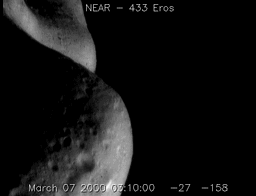|
First Eros Flyover Movie
On March 7, 2000, at a distance of 205 km, the NEAR Shoemaker spacecraft's imager acquired the first of a planned set of "flyover movies" of Eros. Flyover image sequences are made to show the effect of continuously changing illumination direction on a region of the asteroid's surface. This first sequence is focussed on the "saddle" region. As the direction of illumination changes, differently orientated features become more evident. Sunlight that strikes the surface at a low angle highlights topographical features such as troughs, crater rims and boulders by the shadows they cast. When sunlight strikes the surface at near vertical angles, the brightness variations observed are mostly caused by differences in reflectivity of surface materials. The combination of illuminations that occur during a flyover enable effects of topography to be distinguished from differences in reflectivity. Sets of images taken under changing illumination are essential when attempting to characterise a world's landforms from a remote sensing platform. |
 Click on the image to replay the sequence (Product of images 0127808826 through 0127814488) |